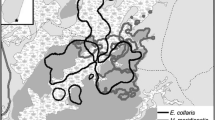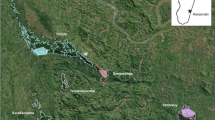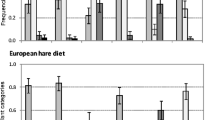Abstract
Using Lepilemur mustelinus as an example of the folivorous guild of lemurs, I address the questions of how potential interspecific competition with Avahi laniger and declining habitat suitability affect its leaf selection and habitat utilization, respectively. The quality of leaves eaten by Lepilemur has been measured in four different forests of Madagascar. Leaf quality was expressed as the ratio of protein to fiber content. In forests where Avahi was absent Lepilemur ate high quality leaves. Where Avahi was present Lepilemur fed on low quality leaves which were inferior to the items eaten by Avahi. Unidentified site effects had no effect on leaf choice of Lepilemur, once the effect of Avahi had been accounted for. This pattern can be considered as behavioral character displacement. Microhabitats used by Lepilemur mustelinus ruficaudatus are characterized by dense stands of trees, interpreted as a prerequisite for locomotion. Up to a certain point Lepilemur tolerates thinning of trees in the wake of logging and uses microhabitats with greater distances between trees. But tree distances in microhabitats used by Lepilemur remain constant when average tree distances are further increased by more intensive forms of logging. This indicates an upper limit due to energetic constraints for distances between trees needed for travel by Lepilemur. Clumping in the distribution of food trees increases with increasing group size from the solitary Lepilemur to the pair-living Avahi to the group-living Propithecus verreauxi. All three results are predicted by deterministic models of optimization theory. This suggests that leaf quality and habitat structure are limiting resources for Lepilemur and that interspecific competition over high quality leaves is an active force in the folivorous guild of Malagasy lemurs.
Access this chapter
Tax calculation will be finalised at checkout
Purchases are for personal use only
Preview
Unable to display preview. Download preview PDF.
Similar content being viewed by others
References
Alatalo, R.V., Eriksson, D., Gustafsson, L., and Larsson, K., 1987, Exploitation competition influences the use of foraging sites by tits: experimental evidence, Ecology 68: 284.
Albignac, R., 1981, Variabilité dans l’organisation territoriale et l’écologie deAvahi laniger (Lémurien nocturne de Madagascar), Compte Rendus Academie Science Paris 292, 111–331.
Andriantsoa-Rahelinirina, L., 1985, Distribution de quelques espèces végétales consommées par les lémuriens dans la forêt d’Ampijoroa, Mémoire de Diplome d’Etudes Approfondies de Sciences Biologique Appliquées, Antananarivo: Université de Madagascar.
Belovsky, G.E., 1984, Moose and snowshoe hare competition and a mechanistic explanation from foraging theory, Oecologia 61: 150.
Box, H.O., 1991, Primate Responses to Environmental Change, Chapman and Hall, London.
Brown, W.L Jr., and Wilson, E.O., 1956, Character displacement, Systematic Zoology 7: 49.
Charles-Dominique, P., and Hladik, C.M., 1971, Le Lépilemur du sud de Madagascar: écologie alimentation et vie sociale, Terre Vie 25: 3.
Charnov, E.L., 1976, Optimal foraging: the marginal value theorem, Theoret. Pop. Biot 9: 129.
Chivers, D.J., 1991, Species differences in tolerance to environmental change, in: “Primate Responses to Environmental Change,” H.O. Box, ed., Chapman and Hall, London.
Chivers, DJ., and Hladik, C.M., 1980, Morphology of the gastrointestinal tract in primates: comparisons with other mammals in relation to diet, J. Morphol. 166: 337.
Chivers, DJ., Wood, BA., and Bilsborough, A., 1984, “Food Aquisition and Processing in Primates,” Plenum Press, New York.
Connell, J.H., 1983, On the prevalence and relative importance of interspecific competition: evidence from field experiments, Amer. Nat. 122: 661.
Covi, S., 1988, Mise en valeur équilibrée d’un écosystème forestier. La reconstition d’un forêt dense sèche après exploitation, in: “L’Equilibre des Ecosystèmes Forestiers à Madagascar: Actes d’un Séminaire International,” L. Rakotovao, V. Barre, and J. Sayer, eds., Gland: UICN.
Dayan, T., Simberloff, D., Tchernov, E., and Yom-Tov, Y., 1990, Feline canines: community-wide character displacement among the small cats of Israel, Amer. Nat. 136: 39.
Deleporte, P., Randrianasolo, J., and Rakotonirina, in prep., Forestry in the dense tropical dry forest, in: “Economy and Ecology of a Tropical dry Forest,” J.U. Ganzhorn and J.-P. Sorg, eds., Springer, Berlin.
Demes, B., Forchap, E., and Herwig, H., 1991, They seem to glide. Are there aerodynamic effects in prosimian primates? Z. Morph. Anthrop. 78: 373.
Diamond, J.M., 1978, Niche shifts and the rediscovery of interspecific competition, Amer. Sci. 66: 322.
Eigen, M., and Schuster, P., 1977, The hypercycle: a principle of natural self-organization, Part A: Emergence of the hypercycle, Naturwiss. 64: 541.
Eigen, M., and Schuster, P., 1978a, The hypercycle: a principle of natural self-organization, Part B: The abstract hypercycle, Naturwiss. 65: 7.
Eigen, M., and Schuster, P, 1978b, The hypercycle: a principle of natural self-organization, Part C: The realistic hypercycle, Naturwiss. 65: 341.
Fleagle J.G., 1984, Primate locomotion and diet, in: “Food Aquisition and Processing in Primates,” D.J. Chivers, BA. Wood, and A. Bilsborough, eds., Plenum Press, New York.
Ganzhorn, J.U., 1988, Food partitioning among Malagasy primates, Oecologia 75: 436.
Ganzhorn, J.U., 1989a, Niche separation of seven lemur species in the eastern rainforest of Madagascar, Oecologia 79: 279.
Ganzhorn, J.U., 1989b, Primate species separation in relation to secondary plant chemicals, Hum. Evol. 4: 125.
Ganzhorn, J.U., 1992, Leaf chemistry and the biomass of folivorous primates in tropical forests: Test of a hypothesis, Oecologia 91: 540.
Glander, K.E., 1982, The impact of plant secondary compounds on primate feeding behavior, Ybk Phys. Anthropol. 25: 1.
Glander, K.E., Wright, P.C., Seigler, D.S., Randrianasolo, V., and Randrianasolo, B., 1989, Consumption of cyanogenic bamboo by a newly discovered species of bamboo lemur, Am. J. Prmatol. 19: 119.
Goodman, S.M., O’Connor, S, and Langrand, O., 1993, A review of predation on lemurs: implications for the evolution of social behavior in small, nocturnal primates, in: “Lemur Social Systems and Their Ecological Basis,” P.M. Kappeler and J.U. Ganzhorn, eds., Plenum Press, New York.
Haffer, J., 1986, Superspecies and species limits in vertebrates, Z. Zool. Syst. Evolutionsforschung 24: 169.
Haken, H., 1990, “Synergetik. Eine Einführung,” Springer, Berl in Heidelberg.
Harcourt, C., and Thornback, J., 1990, “Lemurs of Madagascar and the Comoros”, Gland: IUCN.
Hutchinson, G.E., 1957, Concluding remarks, Cold Spring Harbor Symposia on Quantitative Biology 22: 415.
Johns, A.D., 1991, Forest disturbance and Amazonian primates, in: “Primate Responses to Environmental Change,” H.O. Box, ed., Chapman and Hall, London.
Johns, A.D., and Skorupa, J.P., 1987, Responses of rain-forest primates to habitat disturbance: a review, Int. J. Primato!. 8: 157.
Keddy, PA., 1989, “Competition,” Chapman and Hall, London.
Lee, P.C., 1991, Adaptations to environmental change: an evolutionary perspective, in: “Primate Responses to Environmental Change,” H.O. Box, ed., Chapman and Hall, London.
Ludwig, JA., and Reynolds, J.F., 1988, “Statistical Ecology,” John Wiley and Sons, New York.
MacArthur, R.H., and Levins, R., 1967, The limiting similarity, convergence, and divergence of species, Amer. Nat. 101: 377.
MacArthur, R.H., and Pianka, E.R., 1966, On optimal use of a patchy environment, Amer. Nat. 100: 603.
Maier, W., 1980, Konstruktionsmorphologische Untersuchungen am Gebiß der rezenten Prosimiae (Primates),Abh. Senckenb. Naturforsch. Ges. 538: 1.
Nicoll, M.L., and Langrand, O., 1989, Madagascar: Revue de la Conservation et des Aires Protégées, Gland: WNW.
Oates, J.F., Whitesides, G.H., Davies, A.G., Waterman, P.G., Green, S.M., Dasilva G.L., and Mole, S., 1990, Determinants of variation in tropical forest primate biomass: new evidence from West Africa, Ecology 71: 328.
Petter J.J., Albignac R., and Rumpler Y., 1977, “Faune de Madagascar 44• Mammifères Lémuriens ( Primates Prosimiens),” ORSTOM/CNRS, Paris.
Razanaohera, M. R., 1988, Comportement alimentaire de deux espèces sympatriques dans la forêt d’Ankarafantsika (nord-ouest de Madagascar): Lepilemur edwardsi et Avahi laniger (Lémuriens nocturnes), in: “L’Equilibre des Ecosystèmes Forestiers à Madagascar: Actes d’un Séminaire International,” L. Rakotovao, V. Barre, and J. Sayer, eds., Gland: UICN.
Razanaohera-Rakotomalala, M., 1981, Les adaptations alimentaires comparées de deux lémuriens folivores sympatriques: Avahi JOURDAN, 1834
Lepilemur I. GEOFF’ROY,1851, Thèse de 3ème cycle, Laboratoire de Zoologie-Biologie Générale, Antananarivo: Université de Madagascar.
Richard, A.F., 1978, “Behavioral Variation,” Bucknell University Press, Lewisburg, Pa.
Richard, A.F., 1985, “Primates in Nature,” Freeman, New York.
Richard, A.F., and Dewar, R.E., 1991, Lemur ecology, Ann. Rev. EcoL Syst. 22: 145.
Richard, A.F., Rakotomanga, P., and Schwartz, M., 1991, Demography of Propithecus verreauxi at Beza Mahafaly: sex ratio, survival and fertility, Am. J. Phys. AnthropL 84: 307.
Schmidt-Nielsen, K., 1984, “Scaling: Why is Animal Size so important?” Cambridge University Press, Cambridge.
Schoener, T.W., 1971, Theory of feeding strategies, Ann. Rev. EcoL Syst. 2: 369.
Schoener, T.W., 1983, Field experiments on interspecific competition, Amer. Nat. 122: 240.
Tattersall, I., 1982, “The Primates of Madagascar,” Columbia University Press, New York.
Tattersall, I., 1986, Systematics of the Malagasy strepsirhine primates, in: “Comparative Primate Biology, Vol. 1: Systematics, Evolution and Anatomy,” D.R. Swindler, and J. Erwin, eds., Liss, New York.
Terborgh, J., 1983, “Five New World Primates,” Princeton University Press, Princeton.
Terborgh, J., and Janson, C.H., 1986, The socioecology of primate groups, Ann. Rev. EcoL Syst. 17: 111.
van Schaik, C.P., and Dunbar, R.I.M., 1990, The evolution of monogamy in large primates: a new hypothesis and some crucial tests, Behaviour 115: 30.
van Schaik, C.P., and Kappeler, P.M., 1993, Life history, activity period and lemur social systems, in: “Lemur Social Systems and Their Ecological Basis,” P.M. Kappeler and J.U. Ganzhorn, eds., Plenum Press, New York.
Waterman, P.G., 1984, Food acquisition and processing as a function of plant chemistry, in: “Food Aquisition and Processing in Primates,” D.J. Chivers, BA. Wood, and A. Bilsborough, eds., Plenum Press, New York.
Waterman, P.G., Ross, JA.M., Bennett, E.L., and Davies, A.G., 1988, A comparison of the floristics and leaf chemistry of the tree flora in two Malaysian rain forests and the influence of leaf chemistry on populations of colobine monkeys in the Old World, Biot J. Linn. Soc. 34: 1.
Wiens, JA., 1989, “The Ecology of Bird Communities,” Vol 1 and 2, Cambridge University Press, Cambridge.
Author information
Authors and Affiliations
Editor information
Editors and Affiliations
Rights and permissions
Copyright information
© 1993 Springer Science+Business Media New York
About this chapter
Cite this chapter
Ganzhorn, J.U. (1993). Flexibility and Constraints of Lepilemur Ecology. In: Kappeler, P.M., Ganzhorn, J.U. (eds) Lemur Social Systems and Their Ecological Basis. Springer, Boston, MA. https://doi.org/10.1007/978-1-4899-2412-4_11
Download citation
DOI: https://doi.org/10.1007/978-1-4899-2412-4_11
Publisher Name: Springer, Boston, MA
Print ISBN: 978-1-4899-2414-8
Online ISBN: 978-1-4899-2412-4
eBook Packages: Springer Book Archive




